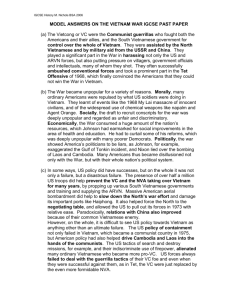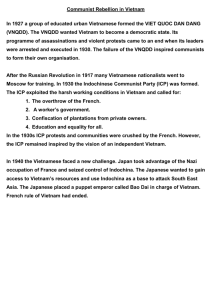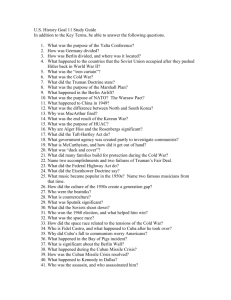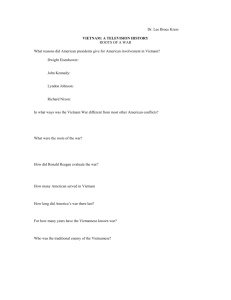Glossary
advertisement
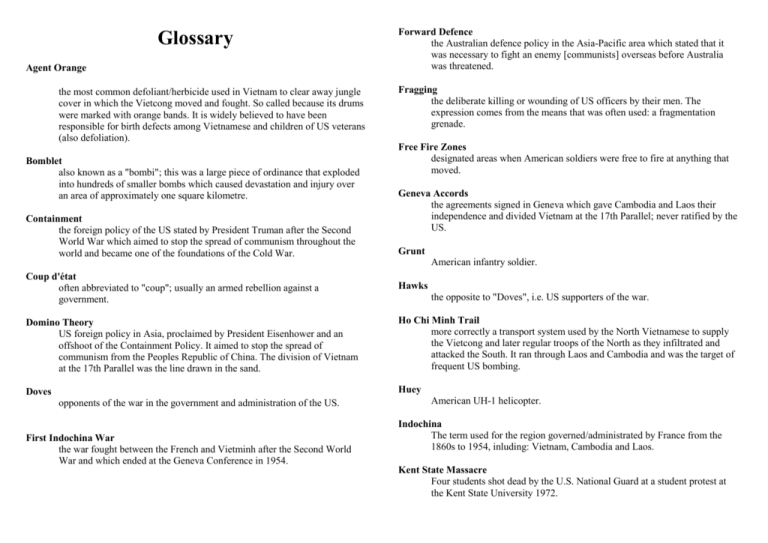
Glossary Agent Orange the most common defoliant/herbicide used in Vietnam to clear away jungle cover in which the Vietcong moved and fought. So called because its drums were marked with orange bands. It is widely believed to have been responsible for birth defects among Vietnamese and children of US veterans (also defoliation). Bomblet also known as a "bombi"; this was a large piece of ordinance that exploded into hundreds of smaller bombs which caused devastation and injury over an area of approximately one square kilometre. Containment the foreign policy of the US stated by President Truman after the Second World War which aimed to stop the spread of communism throughout the world and became one of the foundations of the Cold War. Forward Defence the Australian defence policy in the Asia-Pacific area which stated that it was necessary to fight an enemy [communists] overseas before Australia was threatened. Fragging the deliberate killing or wounding of US officers by their men. The expression comes from the means that was often used: a fragmentation grenade. Free Fire Zones designated areas when American soldiers were free to fire at anything that moved. Geneva Accords the agreements signed in Geneva which gave Cambodia and Laos their independence and divided Vietnam at the 17th Parallel; never ratified by the US. Grunt American infantry soldier. Coup d'état often abbreviated to "coup"; usually an armed rebellion against a government. Hawks Domino Theory US foreign policy in Asia, proclaimed by President Eisenhower and an offshoot of the Containment Policy. It aimed to stop the spread of communism from the Peoples Republic of China. The division of Vietnam at the 17th Parallel was the line drawn in the sand. Ho Chi Minh Trail more correctly a transport system used by the North Vietnamese to supply the Vietcong and later regular troops of the North as they infiltrated and attacked the South. It ran through Laos and Cambodia and was the target of frequent US bombing. Doves Huey opponents of the war in the government and administration of the US. First Indochina War the war fought between the French and Vietminh after the Second World War and which ended at the Geneva Conference in 1954. the opposite to "Doves", i.e. US supporters of the war. American UH-1 helicopter. Indochina The term used for the region governed/administrated by France from the 1860s to 1954, inluding: Vietnam, Cambodia and Laos. Kent State Massacre Four students shot dead by the U.S. National Guard at a student protest at the Kent State University 1972. Khe Sanh a US base in South Vietnam attacked a few days before the Tet Offensive as a diversionary attack. Khmer Rouge the name given by Sihanouk to the Cambodian Communists. Strategic Hamlet Program the policy of the Americans and supported by the RVN by which Vietnamese peasants were removed from their traditional villages and farms and forced to live in "protected" villages that were supposed to be safe from Vietcong infiltration; most commonly used in the Mekong delta. Needless to say, it was a dismal failure. My Lai Tet the village in South Vietnam which became famous for the massacre of the people by US troops under the command of Lt William S. Calley. Napalm jellied petrol, a mixture of gasoline and other chemicals which burst into flame upon exposure to air. It was especially nasty for people as it stuck to the skin while it burned. National Service conscription into the armed services; called "the draft" in America. Pacification the policy which attempted to eliminate Vietcong influence in villages in South Vietnam to try and win the peasants over to the side of the Republic. It failed. Peace with Honour the policy proclaimed by President Nixon as the context in which the US and North Vietnamese sought to end the war. Re-education Camps after the communist victories in Vietnam and Laos, thousands of people who were thought to have supported the former government were sent to these camps in remote areas to be instructed in Marxist theory and recant their former ways. Search and Destroy the main tactic used by American and Australian forces in Vietnam which sought to find Vietcong in villages and then set the village on fire. Second Indochina War The main war studied in the HSC course, also known as the Vietnam War or the War of American Aggression, depending on one’s perspective. the Vietnamese Lunar New Year between late January and mid-February. The Tet festivities in 1968 were marked by a massive communist offensive against the RVN and Americans, which was a turning point in the war as a military defeat but a propaganda victory for the communists. Tonkin Resolution (1964) also known as the Gulf of Tonkin Resolution by which the Congress gave President Johnson extraordinarily wide powers to increase US involvement in the war. It was declared following an alleged attack on the US battleship Maddox by North Vietnamese gunboats in the gulf of the same name. Some historians have seen this as a de facto declaration of war against North Vietnam. Vietcong the common name given to the National Liberation Front (NLF), the guerrilla army that waged much of the war in South Vietnam. Most of its members were from the South, but its strings were pulled from Hanoi. Also known as "Charlie" from "Victor Charlie". Vietminh the umbrella nationalist movement founded by Ho Chi Minh in 1940 with the aim of founding a united and independent Vietnam. Vietnamisation the policy followed by the US towards the end of the war by which the US would withdraw its troops and hand over more of the fighting to the ARVN. Watergate the political scandal which forced President Nixon to resign in 1974 before he was likely to be impeached.
![vietnam[1].](http://s2.studylib.net/store/data/005329784_1-42b2e9fc4f7c73463c31fd4de82c4fa3-300x300.png)

